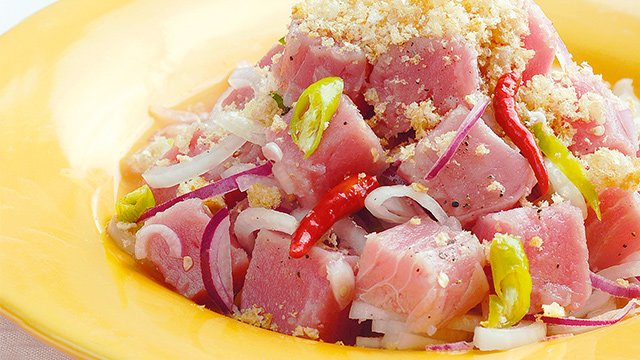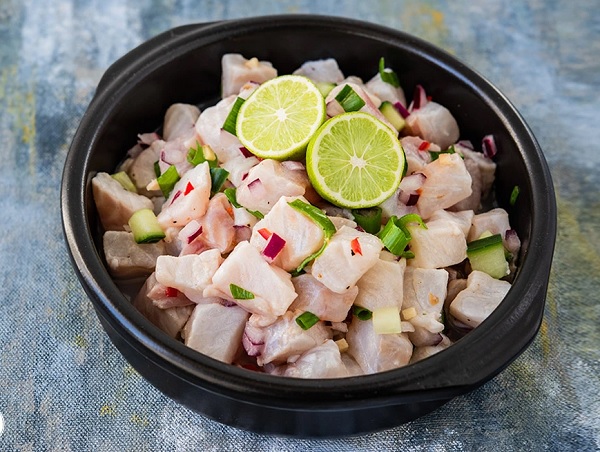Kinilaw Na Tuna Recipe : The Ultimate Guide to Deliciously Fresh Tuna
Looking for an authentic Kinilaw na Tuna recipe? Kinilaw na Tuna is a popular Filipino dish made with fresh tuna, vinegar, and other seasonings.
It’s a refreshing and tangy appetizer or main course that’s perfect for seafood lovers. This traditional dish is known for its fresh flavors and simple preparation, making it a go-to recipe for gatherings and special occasions. The combination of acidic vinegar, spicy chili, and the natural richness of the tuna creates a delightful culinary experience.
Whether you’re hosting a party or simply craving a taste of the Philippines, learning how to make Kinilaw na Tuna will surely impress your guests and tantalize your taste buds. So, let’s explore this delectable dish and discover how to prepare it in your own kitchen.

What Is Kinilaw?
Kinilaw is a popular Filipino dish consisting of raw fish or seafood marinated in vinegar and citrus juices.
The history of kinilaw can be traced back to the pre-colonial era when the indigenous peoples of the Philippines used vinegar and citrus juices to preserve and flavor their catch.
Traditional ingredients for kinilaw include fresh tuna, vinegar, lime or calamansi juice, onions, ginger, and chili peppers, while the fish is typically cubed and mixed with the marinade right before serving.
Choosing The Perfect Tuna
Freshness is key when choosing the perfect tuna for kinilaw. Look for fresh tuna with clear eyes and shiny skin. Types of tuna commonly used for kinilaw include yellowfin tuna and skipjack tuna. Ensure the tuna is sushi-grade for raw consumption. Choosing the right tuna is essential for a delicious and safe kinilaw dish.
Preparing The Tuna
Preparing the Tuna for Kinilaw is a crucial step to ensure a fresh and delicious dish. Start by cleaning the Tuna thoroughly under running water. Remove any dirt or impurities from the fish, paying extra attention to the stomach cavity.
Once the Tuna is clean, cut it into small, bite-sized pieces. Use a sharp knife to achieve clean cuts and ensure that each piece is of uniform size. This will help in marinating the fish evenly and give a consistent taste.
Now comes the time to marinate the Tuna. In a bowl, combine vinegar, calamansi juice, ginger, garlic, onions, salt, and pepper. Mix well to create a tangy and flavorful marinade. Gently toss the Tuna pieces in the marinade, making sure each piece is well-coated.
Allow the Tuna to marinate for at least 30 minutes to an hour. During this time, the acidity of the marinade will help “cook” the fish, giving it a tender texture and enhancing the flavors. Once marinated, your Tuna is ready to be enjoyed as a refreshing and healthy Kinilaw dish!
Delicious Kinilaw Recipes
Kinilaw, a traditional Filipino dish, is a delightful and refreshing seafood salad that is perfect for those who love bold flavors and a tangy kick. One classic variation of kinilaw involves combining fresh tuna with vinegar and coconut milk. The acidity of the vinegar helps to cook the raw fish, while the coconut milk adds a creamy texture and subtle sweetness. To elevate the flavors, another option is to prepare a spicy kinilaw by adding chili and ginger. The heat from the chili and the warmth of the ginger create a delightful contrast to the coolness of the dish. Whichever variation you choose, kinilaw is a delicious and satisfying dish that is perfect for any occasion.
Serving And Presentation
When serving kinilaw na tuna, presentation plays a crucial role in enhancing the overall dining experience. Traditional serving methods often involve garnishes and accompaniments that not only add visual appeal but also complement the flavors of the dish.
Garnishes such as fresh herbs, thinly sliced red onions, and chopped tomatoes are commonly used to add color and texture to the dish. These garnishes not only provide a visual contrast to the tuna but also add a refreshing taste to each bite.
Accompaniments like steamed rice, crispy fried seaweed, and chili dipping sauce are often served alongside kinilaw na tuna. The rice acts as a neutral base to balance the acidity of the dish, while the seaweed offers a delightful crunch. The chili dipping sauce adds a kick of heat for those who enjoy spicier flavors.
Remember, while serving kinilaw na tuna, the goal is to create a visually appealing and flavorful experience that showcases the freshness of the ingredients. The right combination of garnishes and accompaniments can elevate the dish, leaving your guests satisfied and impressed.

Frequently Asked Questions Of Kinilaw Na Tuna Recipe
What Is The Difference Between Kilawin And Kinilaw?
The difference between Kilawin and kinilaw is that Kilawin is a Filipino dish made with cooked meat or seafood, while kinilaw is a dish made with raw or partially raw meat or seafood. Kilawin is typically marinated in vinegar, while kinilaw is marinated in vinegar and citrus juice like calamansi or lime.
Why Is Vinegar Used In Kinilaw?
Vinegar is used in kinilaw for its acid content which “cooks” the raw fish or seafood. It also adds a tangy flavor to the dish. Additionally, it helps in preserving the freshness of the raw ingredients.
What Is The English Name For Kinilaw?
The English name for kinilaw is ceviche. It is a dish of raw fish cured in citrus juices.
What Does Kinilaw Taste Like?
Kinilaw is a Filipino dish known for its tangy and refreshing taste. It has a unique blend of sourness from vinegar and citrus, balanced by the sweetness of fresh seafood. The flavors are enhanced by the addition of onions, ginger, and chili peppers.
Conclusion
To sum it up, the kinilaw na tuna recipe offers a mouthwatering blend of flavors and textures. With its fresh ingredients and zesty marinade, this dish is both a culinary delight and a nutritious choice. Whether you’re a seafood lover looking for a refreshing appetizer or simply seeking to explore the rich flavors of Filipino cuisine, this recipe is a must-try.
Embrace the vibrant flavors of the Philippines and indulge in the wonderful world of kinilaw na tuna!





